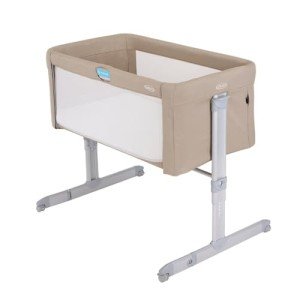The Three Greatest Moments In Bedside Cot For Infants History
The Importance of Bedside Cots for Infants: A Comprehensive Guide
As new parents embark on their parenting journey, they are faced with a myriad of options worrying their infant's sleep arrangements. Amongst these options, the bedside cot stands apart for its myriad of benefits. This article explores the significance of bedside cots, discusses their benefits and drawbacks, answers often asked concerns, and consists of a comparative table to assist parents make informed choices.
What Is a Bedside Cot?
A bedside cot is a sleep space designed to be positioned next to the parents' bed, permitting easy access to the infant during the night. These cots feature adjustable height settings, enabling them to line up with the height of the adult bed. Frequently, they can be connected safely to the bed or remain nearby, supplying a safe yet available sleep environment for the baby.
Types of Bedside Cots
- Co-Sleeping Cots: These cots connect firmly to the parents' bed, enabling for close distance while making sure the baby has their own safe sleeping space.
- Freestanding Cots: These are positioned next to the bed however do not connect directly. They still offer a convenient reach for feeding and reassuring.
- Portable Cots: These cots are light-weight and designed for travel, often featuring collapsible styles and easy-transport abilities.
Advantages of Using a Bedside Cot
Bedside cots offer a number of benefits that can boost both the infant's sleep experience and the parents' peace of mind. These consist of:
1. Improved Safety
According to the American Academy of Pediatrics (AAP), having the infant sleep in the exact same room as parents, without sharing the exact same sleeping surface, considerably lowers the danger of Sudden Infant Death Syndrome (SIDS). A bedside cot uses a safe space while maintaining proximity.
2. Easier Nighttime Care
When a baby is within arm's reach, feeding, diaper modifications, and reassuring becomes a lot more convenient. Parents can quickly soothe their infant without completely waking from sleep or leaving the bed.
3. Support of Bonding
The close proximity provided by a bedside cot motivates bonding throughout nighttime feedings or reassuring. This can foster a complacency for the infant and assistance establish more powerful psychological connections.
4. Space-saving Design
Numerous bedside cots are developed to be compact, making them ideal for small living spaces where a full-sized crib may not fit. They can be quickly moved or kept when not in use.
5. Versatile Functionality
The majority of bedside cots can be changed in height and often feature detachable sides, making them versatile for numerous uses as the child grows or household requires modification.
Disadvantages of Bedside Cots
In spite of their benefits, there are some disadvantages to consider when picking a bedside cot:
1. Limited Lifespan
Bedside cots generally have a shorter life-span than standard cribs, often accommodating infants just approximately a specific weight or height. Parents may need to shift to a full crib quicker than prepared for.
2. Stability Concerns
If not securely connected or appropriately placed, a bedside cot may posture security concerns. Parents must ensure that the cot is steady and well-aligned with the bed.
3. Change Period
Some infants might take some time to get utilized to sleeping in a cot, particularly if they are used to closer contact. Parents might need to be patient as their kid adapts.
How to Choose the Right Bedside Cot
When selecting a bedside cot, parents must consider the following requirements:
- Safety Standards: Ensure the cot complies with all security regulations.
- Adjustability: Look for height-adjustable functions that line up with your bed.
- Building and construction Material: Choose a cot that is strong and made of non-toxic materials.
- Relieve of Use: Opt for designs that allow for one-handed operation when accessing the infant.
Table: Comparison of Popular Bedside Cots
Feature
Co-Sleeping Cot
Freestanding Cot
Portable Cot
Attachment to Bed
Yes
No
No
Adjustability
Yes
Yes
Yes
Travel-Friendly
No
No
Yes
Life-span
6-12 months
18-24 months
0-12 months
Rate Range
₤ 150-₤ 300
₤ 100-₤ 250
₤ 50-₤ 150
Frequently Asked Questions (FAQs)
1. Are bedside cots safe for my baby?
Yes, when used correctly and according to security requirements, bedside cots are safe for infants. It is essential to ensure that the cot is safely located and does not position any threat of falling.
2. At what www.cots4tots.co.uk can I transition my baby from a bedside cot to a crib?
Most parents transition their baby from a bedside cot to a crib between six months and 2 years, depending on the infant's development and comfort level.
3. Can I use a bedside cot for twins?
While some bedside cots are designed to accommodate more than one kid, many are planned for single infants. Parents of twins might require to consider using separate cots.
4. How do I maintain my bedside cot?
Regular cleaning, looking for wear and tear, and ensuring that all components, such as security straps and bed mattress, are in excellent condition, can help maintain your bedside cot.
Selecting the ideal sleep arrangement for an infant is one of the many choices that new parents face. A bedside cot uses unparalleled convenience and safety while allowing for close parental interaction. Comprehending the benefits, drawbacks, and features of bedside cots can empower parents to make the right choice for their family's needs. By weighing these elements together with safety preventative measures, parents can develop a nurturing sleep environment for their children.
